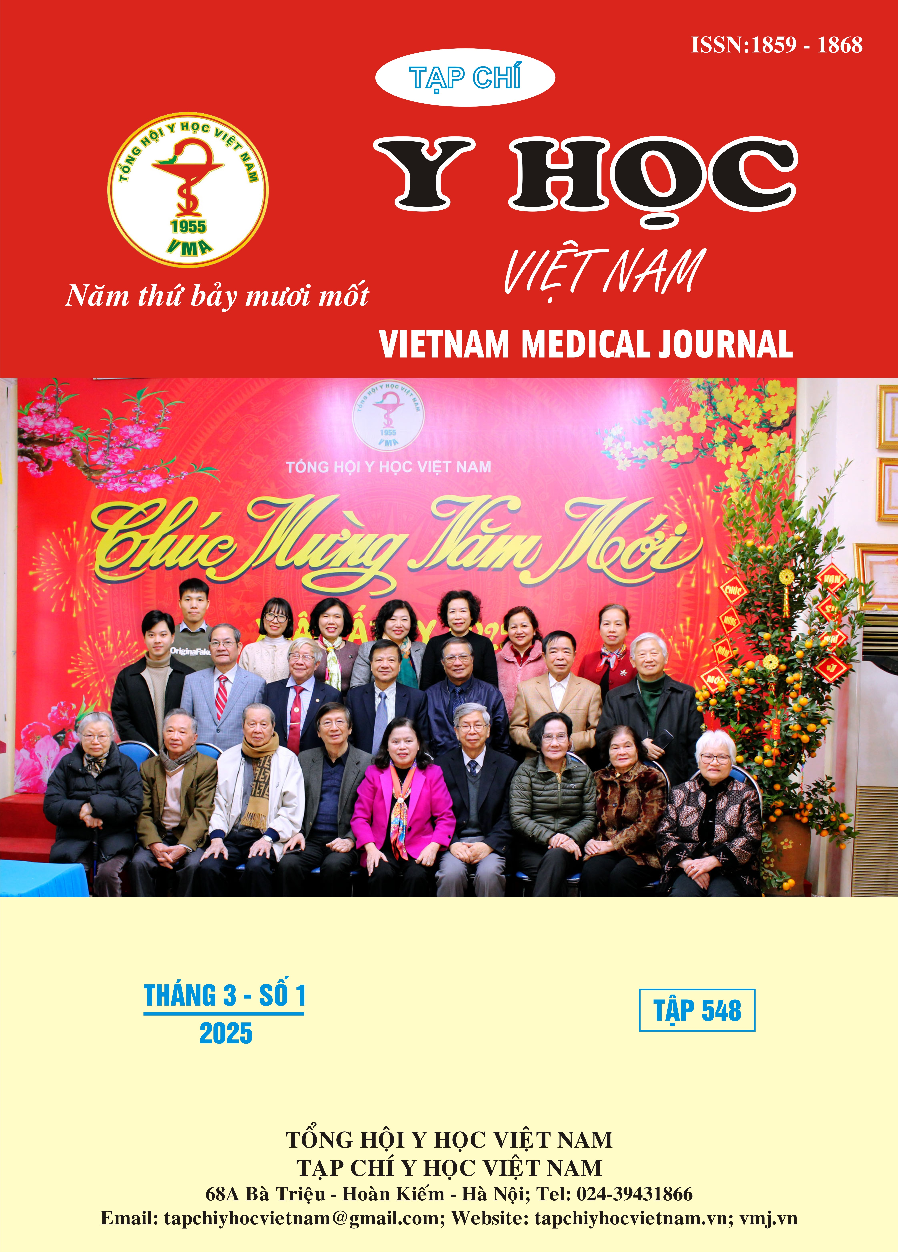IVF OUTCOMES IN COUPLES CARRYING THALASSEMIA GENES AT THE ASSISTED REPRODUCTIVE TECHNOLOGY AND TISSUE ENGINEERING CENTER, HANOI MEDICAL UNIVERSITY HOSPITAL
Main Article Content
Abstract
Objective: To evaluate the impact of embryo quality and preimplantation genetic testing (PGT) results on pregnancy rates among couples carrying Thalassemia genes. Subjects and Methods: This prospective descriptive study was conducted on Thalassemia gene carrier couples undergoing in vitro fertilization (IVF) combined with PGT at the ART & Tissue Engineering Center, Hanoi Medical University Hospital, from May 2022 to June 2024. Results: The study included 26 couples carrying either α-thalassemia (20) or β-thalassemia (6). Among 134 embryos subjected to PGT-A, 57.5% were euploid, 42.5% exhibited aneuploidy ranging from 1 chromosome to more than 4 chromosomes. High-quality embryos (grades 1 and 2) showed a significantly lower rate of aneuploidy compared to low-quality embryos (grade 3) (p<0.05). Following PGT-A, 89 embryos underwent Thalassemia gene screening, with only 26.5% being free of Thalassemia genes, while 73.5% carried at least one gene mutation. No clear correlation was observed between embryo quality and Thalassemia genetic status (p>0.05). Pregnancy rates were 22 out of 29 embryo transfer cycles, with the highest rates observed in women under 35 years old, decreasing significantly with maternal age (p<0.05). Both transferred embryo groups (heterozygous or without abnormal genes) exhibited similar pregnancy rates (p>0.05). Conclusion: In IVF among couples carrying Thalassemia genes, maternal age and embryo quality are critical factors influencing successful pregnancy outcomes. However, genetic status does not appear to significantly affect pregnancy success rates.
Article Details
Keywords
Thalassemia, IVF
References
2. Kahraman S, Ekmekçi GC, Beyazyürek Ç. Preimplantation Genetic Diagnosis in the Prevention of the Haemoglobin Disorders. Thalassemia Reports. 2011; 1(s2):e5. doi:10. 4081/thal.2011.s2.e5
3. Goh LPW, Chong ETJ, Lee PC. Prevalence of Alpha(α)-Thalassemia in Southeast Asia (2010-2020): A Meta-Analysis Involving 83,674 Subjects. Int J Environ Res Public Health. 2020;17(20): 7354. doi:10.3390/ijerph17207354
4. Franasiak JM, Forman EJ, Hong KH. The nature of aneuploidy with increasing age of the female partner: a review of 15,169 consecutive trophectoderm biopsies evaluated with comprehensive chromosomal screening. Fertil Steril. 2014;101(3): 656-663.e1. doi:10.1016/ j.fertnstert.2013.11.004
5. Gardner DK, Balaban B. Assessment of human embryo development using morphological criteria in an era of time-lapse, algorithms and “OMICS”: is looking good still important? Mol Hum Reprod. 2016; 22(10): 704-718. doi:10.1093/molehr/ gaw057
6. Capalbo A, Poli M, Rienzi L. Mosaic human preimplantation embryos and their developmental potential in a prospective, non-selection clinical trial. Am J Hum Genet. 2021;108(12):2238-2247. doi:10.1016/j.ajhg.2021.11.002
7. Rodrigo L, Clemente-Císcar M, Campos-Galindo I. Characteristics of the IVF Cycle that Contribute to the Incidence of Mosaicism. Genes (Basel). 2020;11(10): 1151. doi:10.3390/ genes11101151
8. Hardarson T, Hanson C, Sjögren A. Human embryos with unevenly sized blastomeres have lower pregnancy and implantation rates: indications for aneuploidy and multinucleation. Hum Reprod. 2001;16(2):313-318. doi:10.1093/ humrep/16.2.313
9. Awadalla MS, Vestal NL, McGinnis LK. Effect of age and morphology on sustained implantation rate after euploid blastocyst transfer. Reprod Biomed Online. 2021;43(3):395-403. doi:10.1016/ j.rbmo.2021.06.008
10. Salumets A, Suikkari AM, Mäkinen S. Frozen embryo transfers: implications of clinical and embryological factors on the pregnancy outcome. Hum Reprod. 2006;21(9): 2368-2374. doi:10. 1093/humrep/del151


